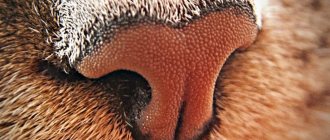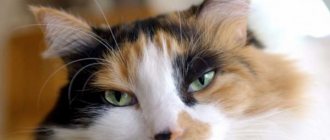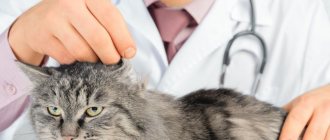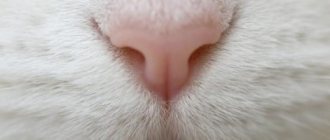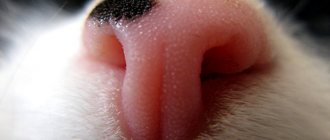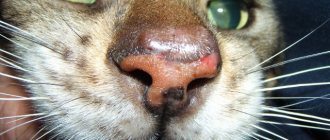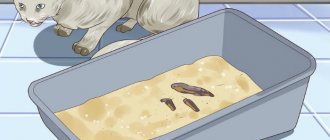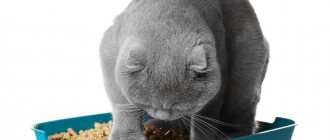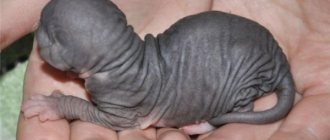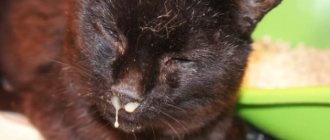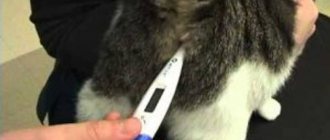The cat's excellent health is characterized by a moist, cool nose, a good appetite and a cheerful state. If a cat has a hot nose, the owner begins to worry and sound the alarm. But there is no need to panic, because the cause of a nose that is hot to the touch may not be colds or infectious diseases, but some factors that do not have a detrimental effect on the body.
A cat may have a hot nose immediately after waking up, and also for some time after sleep. Also, changes in temperature on the nose are noted in domestic cats after active physical activity or stressful situations.
Changes in the condition of the pet's nasal surface are also associated with environmental air. So, indoors, especially during cold periods, when the heating is on, the air may be too dry, which leads to drying out of all the outer mucous membranes, causing a rise in temperature.
Hyperthermia that persists for 2-3 hours, accompanied by changes in the animal’s condition (runny nose, shortness of breath, cough, eruption of gastric contents or diarrhea), requires contacting a veterinarian, as this may indicate the onset of a serious illness.
Changing the color and shape of a cat's nose
Photo: painful nose of a cat
It is worth paying attention when the animal’s olfactory organ changes color and shape. If it becomes scaly or changes color, is dry and its skin cracks, or ulcers open, then this is a reason to contact a veterinarian. Among other things, it is important to monitor its color. At different periods of life, this organ brightens and takes on its normal color. And here it is necessary to differentiate the reasons for the color change. After all, it can lighten due to changes in ambient temperature or due to age-related changes, which is natural. But this is also possible due to the deterioration of the cat’s health. A lighter nose indicates a deterioration in the functioning of the circulatory system, diseases of the internal organs, infections, banal wounds or other physical effects. Therefore, painful color changes are necessarily accompanied by other symptoms.
First diagnosis
A careful examination of the cat is very important to make the correct diagnosis.
If one or more alarming symptoms are observed, the first thing the owner needs to do is carefully examine the pet.
- Check skin and coat.
- Find out the presence or absence of wounds , ulcers, rashes.
- Examine the mucous membranes of the nose , ears and eyes for discharge or discoloration.
- In normal condition, all mucous membranes should be pale pink . If there are deviations in any direction - the color is too pale or bright red, you should immediately consult a doctor.
- Examine and feel the cat's belly for bloating, pain, or increase in size.
- Feel the bladder to determine the level of fullness.
- Carefully inspect the cat's litter box .
- Find out the amount of stool , presence of impurities, change in color, consistency.
Temperature measurement
Every owner's house should have a special thermometer for animals.
Be sure to measure your temperature with a thermometer.
Monitor the cat's breathing. This can be done by placing your hand on your stomach or counting the number of inhalations and exhalations. The norm is from eighteen to thirty-three inhalations and exhalations. Females may have about ten more inhalations and exhalations than males.
If your cat has a dry and hot nose
This is what a problematic dry nose looks like
If this organ of the animal remains dry and hot for more than 2 hours, then this is a reason to worry about its health. The cat needs to be examined and if it is sick, other symptoms will also appear. A sign of health is a cold nose. However, you shouldn’t relax here either, since a too cold nose along with the appearance of symptoms of the disease is a cause for concern. And it will be useful to measure the cat's temperature, which under normal circumstances should be around 38-39 °C.
Signs of vasomotor rhinitis
Non-infectious runny nose is accompanied by the following symptoms:
- nasal congestion occurs periodically due to changes in body position, climate, physical activity or for no apparent reason, and can occur only on one side;
- watery or mucous discharge appears from the nose due to the specified circumstances or for no noticeable reason;
- sneezing for no reason;
- change in voice timbre;
- deterioration of smell.
When conditions change, non-infectious runny nose disappears as quickly as it appeared.
Nasal discharge in a cat
If your pet has nasal discharge, swelling, or is having trouble breathing, it's time to call your veterinarian. These signs indicate the presence of a foreign body inside, infection or even a tumor. If discharge appears from only one nostril, then it may be a foreign body stuck inside. Other signs of these illnesses include sneezing, nose picking, or bleeding. Nasal polyps or tumors often coincide with bloody discharge or mucus from the inside, the cat's breathing becomes noisy, and a bulge or bump may appear on one side of the face.
Check your cat's nose often
Examination of an animal’s olfactory organ is an obligatory part of home life. Knowing the appearance and shape of a cat's nose when it is healthy makes it easier to determine when disease appears. Examine and look for unusual signs, such as nasal discharge, especially if it changes from clear to mucous or bloody, and watch for excessive dryness, crusting, or loss of pigmentation.
Healthy cat nose
Watch your breath
It is also important to monitor how the animal breathes. A healthy cat should breathe through its nose. If the nostrils flare more than usual, your pet may have trouble breathing. It is worth noting that while waiting for the veterinarian, it will not be a bad idea to use vitamin E. You can open the capsule and drop it into the cat’s nose.
It must be remembered that a cat’s nose that is too dry or wet can be a symptom of serious illnesses that cannot be cured on your own. Therefore, at the first suspicion of a disease, the cat should be shown to a veterinarian.
Share this page with your friends!
Differential diagnosis of cough in children and its treatment
Cough is a protective mechanism for cleansing the bronchi and trachea. It occurs when exposed to “fast” or irritative receptors of mechanical and chemical stimuli and to “slow” C-receptors - mediators of inflammation. Rare cough shocks are physiological, they remove accumulation of mucus from the larynx; healthy children “clear their throat” 10–15 times a day, more in the morning, which should not alarm parents.
In the differential diagnosis of cough, it is very important to distinguish between its temporary characteristics: acute cough; persistent cough lasting three or more weeks after an acute episode; recurrent, occurring periodically; long persistent cough.
Types of cough
Acute cough . Characteristic of acute viral catarrh of the upper respiratory tract, as well as inflammation in the larynx (laryngitis, croup), trachea (tracheitis), bronchi (bronchitis) and lungs (pneumonia). When the respiratory tube is damaged, the cough is initially dry, unproductive - it does not lead to the discharge of sputum and is subjectively felt as intrusive. With laryngitis and tracheitis, it often acquires a barking character and a metallic overtone. A dry cough accompanies a sore throat with laryngitis. With pneumonia, the cough is usually wet from the first hours of illness and is often described as deep.
A wet cough is characteristic of a full-blown picture of bronchitis; its shocks end with the discharge of sputum (in small children this is perceived aurally), appearing again when it accumulates. The discharge of sputum is subjectively perceived as relief.
In the differential diagnosis of an acute cough, it is important to verify its connection with infection (fever, the presence of catarrhal syndrome). In a child with signs of acute respiratory viral infection (ARVI), hoarseness and difficulty in breathing indicate damage to the larynx with a possible threat of asphyxia (croup). Moist rales in both lungs indicate bronchitis: in older children they are usually large- and medium-bubble, in small children they are often small-bubble, which allows a diagnosis of bronchiolitis.
The key task in the presence of signs of acute respiratory infections is to exclude pneumonia - most often, wheezing is absent in the lungs or is heard over a limited area of the lung, where a shortening of the percussion sound and/or a change in the breathing pattern is also detected. The nature and strength of the cough does not indicate the etiology of pneumonia. An exception is the stokato cough in children with chlamydial pneumonia in the first months of life: “dry”, abrupt, ringing, followed by attacks, but without reprisals, accompanied by tachypnea, but not a febrile reaction.
Spasmodic cough is characteristic of bronchial asthma, and in children of the first years of life - with acute obstructive bronchitis or bronchiolitis. In these forms, wheezing is accompanied by prolongation of exhalation, which indicates the presence of bronchial obstruction. A spasmodic cough is usually unproductive, intrusive, and often has a whistling overtone at the end.
In the event of a sudden onset of cough, including spastic cough, without signs of acute respiratory viral infection, you should think about a foreign body in the respiratory tract, especially in a child who has not previously had a spastic cough. It is characterized by an attack of whooping cough - obsessive, but not accompanied by reprises. This cough may last for a short time; when a foreign body moves into the smaller bronchi, the cough may stop. A foreign body is often accompanied by swelling of one lung, over which weakening of breathing and, often, whistling exhalation are heard; with such symptoms, bronchoscopy is indicated.
Prolonged cough (more than 2 weeks). It is observed quite often, usually after acute bronchitis. Most often, it is associated not so much with the inflammatory process as such, but with post-infectious hyperproduction of sputum and, often, with hypersensitivity of cough receptors. When deciphering such a cough, it is important to take into account the child’s age.
In infants after obstructive bronchitis, the persistence of hypersecretion of mucus with an increase in the cough threshold causes a rare wet cough for 4 weeks or more; its distinctive feature is the presence of “hoarseness” - bubbling sounds in the chest, audible at a distance, which disappear after coughing and reappear as sputum accumulates. Sputum from the trachea and larynx in infants is evacuated by more rare cough shocks, when the lumen of the bronchi is almost completely blocked. In such children, coughing with pressure on the trachea (or with a spatula on the root of the tongue) is difficult to induce. The cough associated with hypersecretion gradually subsides, both in frequency and intensity.
However, cough associated with habitual aspiration of food due to dysphagia, the most common cause of prolonged cough in infants, both breastfed and artificially, should be excluded. Establishing the fact of dysphagia usually requires monitoring the feeding process, since not every mother pays attention to the connection between cough and food intake. In addition to “choking” and “coughing” during food, food aspiration is characterized by the appearance of wheezing, which quickly disappears or changes its location and intensity after a cough impulse. Chest radiography in such children usually reveals darkening or intensification of the pulmonary pattern in the upper lobes.
Cough when eating is also observed in the presence of a bronchoesophageal fistula; its distinctive feature is the separation of copious frothy sputum; the presence of this symptom requires a contrast study of the esophagus and esophagoscopy.
Children who, in addition to dysphagia, have gastroesophageal reflux are characterized by coughing attacks during sleep. Finding a wet pillow confirms this diagnosis.
A lingering cough in children of early and preschool age is often caused by the flow of mucus into the larynx from the nasopharynx with long-term nasopharyngitis, adenoiditis, and adenoid hypertrophy; Unlike cough with bronchitis, it is not accompanied by wheezing in the lungs, often has a superficial character and disappears when the process in the nasopharynx is treated. A prolonged episode of bronchitis with cough lasting 2–4 weeks is common in preschoolers with recurrent bronchitis.
A prolonged dry cough in school-age children and adolescents, which can last up to 6 weeks, is not uncommon with tracheitis or tracheobronchitis, which develops with certain respiratory viral infections (RS, rhino-, parainfluenza viruses). It is often painful, paroxysmal, and the attack ends with the discharge of a lump of dense mucus (fibrinous deposits). Special studies, however, have shown that among children of this age who have been coughing for more than 2 weeks, 25% or more experience whooping cough in their characteristic atypical form - without pronounced paroxysms and relapses.
This course of whooping cough is typical for both incompletely vaccinated children and children who received 3 vaccinations and revaccination at 18 months. The fact is that pertussis immunity gradually fades away and after 5–6 years—by school age—most vaccinated people become susceptible to this infection. Its atypical course in them contributes to late diagnosis (if it was carried out at all) and the spread of infection and infection of infants who have not yet received all vaccinations.
A lingering cough in adolescents with whooping cough is characterized by the absence of wheezing in the lungs; it usually does not intensify and does not acquire a specific character, as in those who have not been vaccinated. Sometimes, however, it is possible, by pressing with fingers on the trachea or with a spatula on the root of the tongue, to cause a semblance of a whooping cough shock with protrusion of the tongue, redness of the face, less often with a typical reprise. A bacteriological diagnosis of whooping cough in these children is rarely possible; it is more reliable to determine in the blood of antitoxic antibodies, which in sick people, unlike vaccinated ones, are present in high titers.
Recurrent cough . It is typical, first of all, for patients with bronchial asthma - this is one of the frequent complaints of parents of children whose asthma diagnosis has not yet been established. The cough that accompanies almost every episode of acute respiratory viral infection is also characteristic of recurrent bronchitis - it is usually wet, lingering, its duration exceeds 2 weeks, it is not accompanied by obvious signs of bronchospasm, which, however, is often detected during the study of pulmonary function (PRF) (test with bronchodilators).
With recurrent obstructive bronchitis (ROB) in children under 3–4 years of age, a cough—wet or “spastic”—occurs against the background of ARVI, usually in the presence of fever and catarrhal syndrome. Unlike cough in bronchial asthma, it does not have the character of an attack. However, by the type of cough, these two forms can hardly be distinguished, since cough and obstruction due to ARVI are the most common type of exacerbation of bronchial asthma, especially in young children. For many of them, the diagnosis of ROB eventually “flows” into the diagnosis of asthma, if such episodes are repeated more than 3-4 times or if periods of coughing are associated not with ARVI, but with an allergen, physical activity, cold air, or if they occur for no apparent reason at all - as a consequence of increased inflammatory changes in the bronchial mucosa.
Long, persistent cough . It is observed in chronic diseases of the respiratory system, which immediately distinguishes it from the types of cough described above. Of course, it can intensify or weaken at certain periods of time, but it is fundamentally important that the child coughs almost constantly.
A wet, persistent cough is observed in most suppurative lung diseases, accompanied by accumulation of sputum. The cough is often especially severe in the morning, and becomes less frequent after sputum has been removed. A cough that is “deeper” to the ear is typical of bronchiectasis; with defects of the bronchial cartilage (Williams–Campbell syndrome), it may have spastic overtones.
In cystic fibrosis, the cough is often intrusive and painful due to the viscosity of the sputum, often accompanied by signs of obstruction. The diagnosis is not difficult in the presence of other manifestations of cystic fibrosis - weight loss, polyfecal matter, tympanic fingers, etc., however, there are milder forms of this disease, so a study of sweat electrolytes is indicated in all children with a persistent cough.
A persistent dry cough with a change in voice may indicate laryngeal papillomatosis. A dry cough accompanied by shortness of breath, chest deformation, signs of cor pulmonale, and tympanic fingers is characteristic of fibrosing alveolitis.
Psychogenic cough deserves special attention , for which a persistent cough is also typical. This is usually a dry cough with a metallic tint, which is observed only in the daytime and disappears during sleep; its distinctive feature is regularity and high frequency (up to 4-8 times per minute), stopping during eating and talking. A psychogenic cough usually occurs as a reaction to stressful situations in the family and school, then becomes habitual; it often begins during an acute respiratory infection, quite quickly acquiring the character described above. In some children, this cough has the character of a tic or a manifestation of obsessive-compulsive disorder (Gilles de la Tourette syndrome).
Young children often cough when stressed, usually to achieve their goals; The cough intensifies before and during the doctor’s examination, stopping at the end of it (relieving “anticipation stress”). A new coughing attack can be provoked by touching on a topic that is unpleasant for the child (whims, keeping a daily routine) or even by simply starting an abstract conversation, without paying attention to the child. The reason for the strengthening of the cough reflex in a child may be increased anxiety of parents and concentration of their attention on respiratory symptoms. Such children require an in-depth examination to exclude organic pathology, sometimes trial treatment with antispasmodics and steroid aerosols.
Some types of cough differ in nature.
Bitonal cough (low, then high tones). Occurs with tuberculous granulations from a lymphobronchial fistula, sometimes with foreign bodies in large bronchi. Is an indication for bronchoscopy.
Cough when taking a deep breath . Accompanied by pain, indicates pleural irritation; it goes away after pain relief (codeine, Promedol). The same cough during restrictive processes is associated with increased lung rigidity (allergic alveolitis). Taking a deep breath also causes a cough in children with asthma - it occurs as a result of bronchial hyperreactivity; shallow breathing is an integral part of a number of physical therapy (physical therapy) systems used to treat asthma.
Night cough . Characteristic of bronchial asthma, it usually occurs closer to the morning due to increased bronchospasm; It often indicates an allergy to the feathers in the pillow. In some children, nocturnal cough is the equivalent of asthma, so these children should be assessed accordingly. Night cough is also observed with gastroesophageal reflux, while older children complain of heartburn. Quite often, night cough occurs in children with sinusitis or adenoiditis due to mucus entering the larynx and drying of the mucous membrane when breathing through the mouth.
Cough during exercise is a sign of bronchial hyperreactivity and is observed in a significant proportion of patients with bronchial asthma.
Cough with syncope - short-term loss of consciousness - occurs due to a decrease in venous inflow with an increase in intrathoracic pressure and, as a result, a decrease in cardiac output; The condition is benign and does not require treatment other than antitussives.
Cough treatment
The fight against cough has been fought by humanity since time immemorial - even now, when we know so much about cough, both parents and many pediatricians consider cough as an undesirable symptom and strive to stop it. Complaints about cough and persistent requests from parents to treat the cough are apparently connected not only with the fact that cough is a clear sign of a child’s ill health. Subjectively, the cough of a person nearby or in a close environment is perceived as an irritating, unnerving phenomenon. Hence the desire to stop coughing at all costs.
What new does the modern understanding of the nature of cough give us? Firstly, that there are several causes of cough and that it only makes sense to suppress coughs caused by “dry” inflammation of the mucous membrane of the respiratory tract - for example, with laryngitis, as well as coughs associated with irritation of the pleura. In those cases when the cough leads to the removal of sputum, suppressing it is impractical and even dangerous. It is important to explain to parents that coughing is a protective reaction aimed at clearing the airways in conditions of hypersecretion of mucus and reduced efficiency of mucociliary clearance. In practice, treatment of cough as such is required only in rare cases when it significantly disrupts the patient’s life.
Antibiotics . First of all, it is important to understand that the presence of a cough in itself is not a reason for antibiotic therapy. It is carried out only in cases of proven bacterial infection of the upper respiratory tract (otitis media, sinusitis, streptococcal tonsillitis) and lung damage (pneumonia, including chronic pneumonia, cystic fibrosis, lung malformations). With regard to acute bronchitis, it has been proven that antibacterial therapy is justified only for mycoplasma and chlamydial etiology (10–15% of the total number of bronchitis, more often at school age), while the majority of bronchitis, including obstructive ones, are viral diseases.
Antibacterial treatment of whooping cough, including those that occur in the form of a prolonged cough with an early onset (in the first 7–10 days), can interrupt clinical manifestations. At a later date, it is difficult to expect a great effect from antibiotics, but such treatment stops the release of bacilli within 2-3 days, so it is completely justified from an epidemiological point of view. Erythromycin (50 mg/kg/day) and clarithromycin (15 mg/kg/day) for 10–14 days or azithromycin (10 mg/kg/day) for 5 days have proven effectiveness.
Data on the use of the local antibiotic fusafungin (Bioparox) after tonsillectomy and adenotomy operations, as well as for adenoiditis and ARVI, have been published in the literature, primarily by otolaryngologists. The drug also has a local anti-inflammatory effect. Taking into account the fact that during ARVI, pneumococci and Haemophilus influenzae multiply, its use may be justified in children at risk. However, for proven bacterial infections (streptococcal tonsillitis, otitis media, etc.), Bioparox does not replace systemic antibiotics.
Treatment of laryngitis . When a barking cough accompanies laryngitis, it is customary to inhale hot steam - for example, in a bathroom with an open hot water tap. However, this type of treatment has been proven to be ineffective for both croup and bronchitis. A meta-analysis of numerous studies on the treatment of croup has shown that intramuscular dexamethasone (0.6 mg/kg) or, in milder cases, inhaled budesonide (Pulmicort) is most effective in preventing the development (or progression) of laryngeal stenosis. These remedies also help to quickly stop coughing.
Antitussives and expectorants . A dry cough is theoretically an indication for the prescription of antitussive drugs, but in most cases of ARVI, after a few hours it gives way to a wet cough, in which these drugs are contraindicated. As antitussives in children, mainly non-narcotic drugs are used - butamirate, dextromethorphan, glaucine, oxeladine, pentoxyverine (
). A recent study showed, however, that a spoonful of buckwheat honey at night calmed nocturnal coughs in children 2–18 years old with acute respiratory viral infections at least as well as a dose of dextromethorphan. And milk with alkali, tea with jam, etc. “homemade” remedies soothe a barking cough with pharyngitis (sore throat) no worse than “antiseptic” lozenges or sprays. This gave WHO grounds to recommend only home remedies for coughs.
In cases where it is necessary to prescribe medications for pharyngitis, taking into account the fact that most drugs contain antiseptics that disrupt the biocenosis of the oral cavity, it is preferable to use inhalations of Bioparox, a bacteriostatic agent that also has anti-inflammatory effects.
With a wet cough, cough suppression is unacceptable, so intervention is justified only if there is difficulty in sputum evacuation. The effectiveness of expectorants (mainly of herbal origin) is highly questioned; in addition, their use in young children may be accompanied by an allergic reaction and vomiting. However, these remedies (preparations of mint, marshmallow, licorice, oregano, coltsfoot, anise, wild rosemary, thyme, etc.) are widely used, which can be justified by their cheapness and safety (Table 2). But the use of expensive forms of such products, even if they contain extracts of exotic plants (Greenland herbs, quebracho, ivy leaves), cannot be justified. Rubbing the chest with preparations containing essential oils (eucalyptus, pine needles, etc.) and balms that are absorbed by the skin are no more effective than expectorants.
There are combination products on sale that contain both expectorants and antitussives (Bronholitin, Tussin, etc.) (). The idea of their creation is to make coughing less frequent, but more productive, which should reassure parents. These combinations also do not have proven effectiveness in children, but their testing in adult patients showed that such combinations do not improve sputum discharge, but significantly reduce respiratory function. It is unlikely that after this we can seriously recommend these remedies for practice.
Mucolytics . The use of mucolytics is more justified, especially in chronic diseases accompanied by an abundance of viscous sputum (cystic fibrosis, chronic pneumonia, bronchial malformations). The most pronounced mucolytic effect is that of N-acetylcysteine, which in pediatric practice is used mainly for cystic fibrosis and chronic pulmonary suppuration. However, it is difficult to classify it as an essential drug: for example, in the USA, acetylcysteine is used relatively rarely in patients with cystic fibrosis, with preference given to vibration massage. In the presence of purulent sputum in patients with cystic fibrosis, Pulmozyme (dornase-alpha) is indicated, which breaks down the DNA that accumulates in the sputum during the breakdown of cellular elements (
). The use of these agents is permissible only in conditions where postural drainage can be carried out after their administration.
Acetylcysteine should not be used in acute diseases, including bronchitis, since viscous sputum is rare in them, and there are no possibilities for postural drainage in case of “swamping” of the lung with liquid sputum, and this drug is approved from 12 years of age.
In acute and recurrent bronchitis, improvement of mucociliary transport is better achieved with the help of carbocysteine and ambroxol, the latter can be used both orally and as an aerosol in children receiving inhaled sympathomimetic for obstructive bronchitis.
Suppressing the cough that accompanies obstructive syndrome is also not an end in itself - the use of sympathomimetics, eliminating bronchospasm, also contributes to the cessation of cough (
). In case of status asthmaticus, accompanied by the formation of bronchial casts, attempts to use N-acetylcysteine can lead to increased bronchospasm.
Anti-inflammatory drugs . The use of locally acting inhaled corticosteroids (ICS) forms the basis of the treatment of moderate and severe bronchial asthma. Both metered dose inhalers (beclomethasone, budesonide, fluticasone) and nebulizer solutions with budesonide (Pulmicort) are used, especially in children under 3–5 years of age (Table 5). By suppressing inflammation in the bronchial mucosa, ICS help stop the cough it causes.
ICS can also be used for more severe respiratory infections, in which cough is associated primarily with an inflammatory process in the bronchial mucosa. In particular, the use of these drugs during the convulsive period of whooping cough reduces the frequency of coughing attacks and its intensity. ICS (together with sympathomimetics) can be used in the treatment of obstructive bronchitis (especially relapse of bronchitis) in young children. And although ICS does not shorten the duration of the disease, they have a positive effect on the severity of the acute period; There is also evidence of a reduction in the frequency of relapses of obstruction with continued treatment with ICS for 2–4 weeks after the end of the acute period. With prolonged cough due to tracheitis, ICS also often bring lasting relief.
The use of ICS, for obvious reasons, cannot be a “cough control” for most respiratory infections. An alternative to them is the non-steroidal anti-inflammatory drug fenspiride (Erespal - syrup 2 mg/ml), which, as a rule, does not have serious side effects. This drug improves mucociliary clearance, has activity as an antispasmodic and a blocker of H1-histamine receptors. In many patients, especially with recurrent bronchitis, including obstructive, chronic pathology, Erespal (at a dose of 4 mg/kg/day, in children over 1 year - 2-4 tablespoons per day) brings clear relief of cough and condition generally.
Treatment of psychogenic cough . Children with psychogenic cough are usually not helped by antitussives, expectorants, muco- and antispasmodics. Their treatment (after excluding a possible organic cause of cough) usually requires the prescription of antipsychotics, hypnotherapy and is carried out in conjunction with neuropsychiatrists. In the presence of compulsive-obsessive type disorders, there is experience in using slowly increasing doses of Clonidine. Treatment usually requires considerable time (many months), although in some cases the cough may suddenly disappear and begin again (in some cases in the form of obsessive sneezing).
V. K. Tatochenko , Doctor of Medical Sciences, Professor of the Scientific Center for Children's Medicine of the Russian Academy of Medical Sciences , Moscow
Should I worry?
In fact, cats are such vulnerable and delicate creatures that many everyday factors can provoke a short-term increase in temperature or cause their nose to warm up. Answers to the question “why does a cat have a hot nose?” there may be several:
- the pet is sleeping or has just woken up, and after it has warmed up in its sleep, its temperature is slightly elevated;
- the cat experienced stress (the appearance of another pet in the house, moving to a new place, someone loudly shouted at him);
- the animal was scared of something (loud noise, barking dog, vacuum cleaner, etc.);
- the furry friend showed too much activity, played, jumped, etc.
How to take your pet's temperature
You should not postpone a visit to the doctor in cases where the cat has a hot nose for a long time and at the same time he has a lack of appetite and apathy. But in order to understand whether a hot nose really signals us about the temperature and whether it is worth exposing the cat to stress by taking it to the clinic for an unnecessary examination, you can measure the temperature at home, on your own.
In cats, this is done basally (that is, through the anus). Few cats will accept this owner's idea with enthusiasm, and you need to be prepared for the fact that the animal will resist and will not sit quietly for 5 minutes with a thermometer in its butt. Therefore, it is advisable that the procedure be carried out by 2 people, one of whom could hold the furry patient well at all times. In this case, it is desirable that the thermometer body be plastic and not glass.
We must remember that the body temperature of our tailed friends is several degrees higher than that of humans. So values around 38°-39° are acceptable for cats. But a temperature above 39° should be a signal that it’s time to show your pet to the veterinarian.
How to examine an animal yourself?
First, pay attention to the color of your nose and oral mucosa. Touch the paws and inspect them for redness.
IMPORTANT: if the nose is black, inspect the eyelids and the surface of the mucous membrane in the animal’s mouth.
This is what anemia looks like on the oral mucosa
– pallor of the mucous membrane occurs with hypothermia, the development of anemia, the initial stage of poisoning;
– yellow color of the mucous membrane indicates liver disease;
– bluish color of the mucous membrane may indicate a malfunction of the heart;
– redness is characterized by infections, inflammations, allergies, increased temperature and pressure.
Next, using a stopwatch, you can measure the cat's pulse from the inside of the thigh. Feel the pulsation and count the tremors for 15 seconds. Multiply the sum of calculations by 6, so you will determine the number of beats per minute.
An example of how to measure a cat's pulse at home
IMPORTANT: the animal’s normal pulse is no more than 140 beats per minute. The animal's pulse may change during the mating season.
Advice for caring owners
Many of us, loving our cats madly, noticing their hot nose, immediately run to the computer and start looking for advice on various forums on what to do. Having read the advice of various “expert breeders”, the owners risk only aggravating the condition of their furry friend. You can read absolutely ridiculous advice on the Internet, for example: pour a teaspoon of vodka into the cat’s mouth, pick her some grass along the road, mix an Aspirin or Paracetamol tablet into her food.
Such methods, especially with the use of alcohol, can undermine the health of even an absolutely healthy animal.
No matter how great the temptation may be to “save” your sick tailed friend on your own, remember that an animal, just like a person, should only be prescribed any drug by a doctor. If a cat shows symptoms of a real illness, find the money, time and show it to the veterinarian, because the most important thing is not to harm the animal with your care.
What measures should be taken
Only a doctor can diagnose the presence of a dangerous pathology in combination with external signs.
IMPORTANT: if you notice an illness, you can measure the animal’s pulse and temperature - this is the permissible maximum of measures that you can take at home before the veterinarian arrives. Diagnostics and other medical procedures are carried out only by a specialist!
You can help your animal by eliminating external factors that can cause changes in the nose:
- Regulate the heating temperature of the room, and thoroughly dry the animal’s fur after water treatments. Make sure that the cat is in a warm and comfortable environment, this way you will prevent your pet from becoming hypothermic.
- If your pet spends time outside in hot weather, constantly replenish the supply of clean and fresh water, make sure that the cat has access to a cool place. The animal will feel dehydration and will help its body on its own.
IMPORTANT: with a sunburn, the skin on the nose turns red and becomes hot and painful. In this case, Panthenol gel will help you; you should apply it carefully, avoiding getting into the nostrils. Make sure that the animal does not have other alarming symptoms.
A red and sore nose may be a sign of sunburn
- Humidify the indoor air and regularly ventilate the room in which your pet is located.
- Protect your cat from any factors that cause fear or stress in the animal.
- After consulting a veterinarian, you can learn how to clear your pet’s nose of snot and dirt on your own - this way you will make your animal’s life easier. Nasal rinses are purchased at a veterinary pharmacy, and the first rinse is carried out under the supervision of a veterinarian.
- The position of a cat before giving birth requires special attention: the animal is susceptible to stress, pain and emotional outbursts. Monitor the cat's condition, provide care and, if necessary, call a doctor at home.
